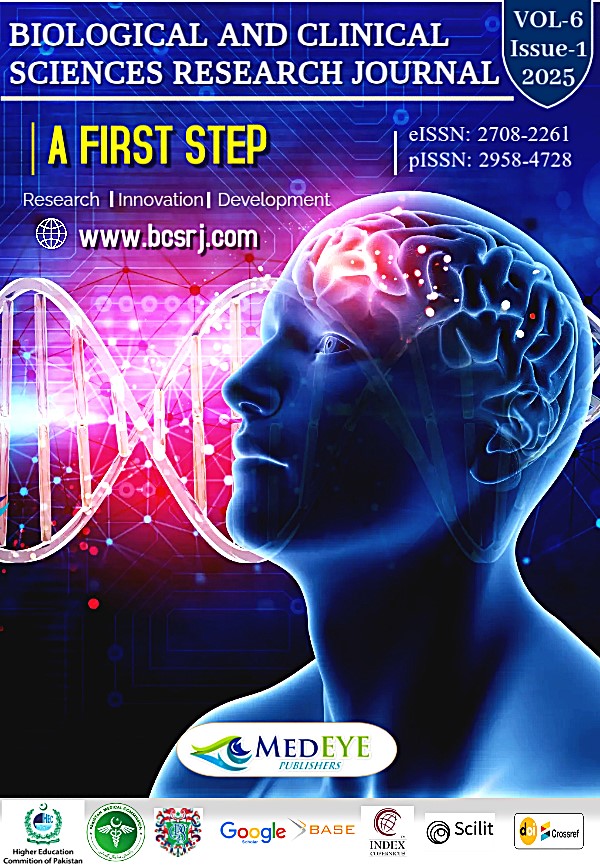Clinical and Immunological Manifestations of Patients Presenting With Systemic Lupus Erythematosus At Tertiary Care Hospital, Karachi
DOI:
https://doi.org/10.54112/bcsrj.v6i1.1545Keywords:
Systemic Lupus Erythematosus (SLE), Autoantibodies, Anti-dsDNA, Clinical Manifestations, Cardiovascular Risk, Lupus Nephritis, Antiphospholipid Syndrome.Abstract
Systemic Lupus Erythematosus (SLE) is a chronic autoimmune disease that affects multiple organ systems, with a high prevalence among young women. It presents various clinical and immunological manifestations, including arthritis, skin rashes, oral ulcers, hematological abnormalities, and neurological involvement. Early diagnosis and management depend on recognising key clinical symptoms and autoantibody profiles. Understanding SLE patterns in different populations is essential for improving diagnostic accuracy, treatment strategies, and patient outcomes. Objective: This study aims to assess the clinical and immunological characteristics of SLE patients in a tertiary care hospital, identifying common symptoms, disease manifestations, and associated autoantibodies. Methodology: A cross-sectional study was conducted on 131 patients diagnosed with SLE at a tertiary care hospital. Data were collected on demographics, clinical symptoms, and immunological markers, including antinuclear antibodies (ANA), anti-dsDNA, anti-Sm, anti-Ro, anti-La, and antiphospholipid antibodies. Statistical analysis was performed using SPSS version 23 to determine the prevalence and associations of disease manifestations. Results: The study population had a strong female predominance (77.9%), with most patients aged 20–40 (77.9%). Arthritis (67.2%), skin rash (67.2%), oral ulcers (77.1%), and photosensitivity (67.2%) were the most frequent symptoms. Neurological involvement was noted in 36% of patients, while hematological abnormalities included hemolytic anemia (31.3%), thrombocytopenia (29.8%), and leukopenia (13%). Immunological analysis showed ANA positivity in 78.6% of patients, with anti-dsDNA (61.1%) as the most common specific autoantibody. Other antibodies included anti-Sm (20.6%), anti-Ro (15.3%), anti-La (14.5%), and anti-RNP (10.7%). Antiphospholipid antibodies were present in 15.3%–13.7% of patients, indicating a risk of thrombotic complications. Comorbid conditions, such as hypertension (32.8%), diabetes (21.4%), dyslipidemia (16.8%), smoking (25.2%), and obesity (23.7%), were also prevalent, highlighting increased cardiovascular risk. Conclusion: The findings emphasise arthritis, skin rash, oral ulcers, and anti-dsDNA positivity as key features of SLE diagnosis. The high prevalence of autoantibodies and cardiovascular risk factors calls for regular monitoring, multidisciplinary management, and early intervention to improve patient outcomes. Future research should focus on long-term disease progression and genetic predisposition, with more extensive multicenter studies to refine diagnostic and treatment strategies.
Downloads
References
Crispín JC, Liossis SN, Kis-Toth K, Lieberman LA, Kyttaris VC, Juang YT, et al. Pathogenesis of human systemic lupus erythematosus: recent advances. TMM. 2010 Feb 1;16(2):47-57.
Kiriakidou M, Ching CL. Systemic Lupus Erythematosus. Ann Intern Med 2020; 172(11):ITC81–ITC96.
Fortuna G, Brennan MT. Systemic lupus erythematosus: epidemiology, pathophysiology, manifestations, and management. Dental Clin North America 2013, 57(4), 631–55.
Barber MRW, Drenkard C, Falasinnu T, Hoi A, Mak A, Kow NY et al. Global epidemiology of systemic lupus erythematosus. Nature Rev Rheumat 2021;17(9):515–32.
Newman K, Owlia MB, El-Hemaidi I, Akhtari M. Management of immune cytopenias in patients with systemic lupus erythematosus—old and new. Autoimmune Rev 2013 May 1;12(7):784-91.
Fava A, Petri M. Systemic lupus erythematosus: Diagnosis and clinical management. J Autoimmunity 2019; 96:1–13.
Tomczyk-Socha M, Sikorska-Szaflik H, Frankowski M, Andrzejewska K, Odziomek A, Szmyrka, M. Clinical and immunological characteristics of Polish patients with systemic lupus erythematosus. Advances in clinical and experimental medicine: official organ Wroclaw Med Uni 2018; 27(1):57–61.
Pan L, Liu J, Liu C, Guo L, Punaro M, Yang S. Childhood-onset systemic lupus erythematosus: characteristics and the prospect of glucocorticoid pulse therapy. Frontiers Immunol 2023; 14:1128754.
Qi YY, Zhou XJ, Zhang H. Autophagy and immunological aberrations in systemic lupus erythematosus. European J Immunol 2021;49(4):523–33.
Yu H, Nagafuchi Y, Fujio K. Clinical and Immunological Biomarkers for Systemic Lupus Erythematosus. Biomolecules 2021;11(7):928.
Aringer M, Petri M. New classification criteria for systemic lupus erythematosus. Current Opinion Rheumat 2020;32(6):590–96.
Huang X, Zhang Q, Zhang H. A Contemporary update on the diagnosis of systemic lupus erythematosus. Clinic Rev Allerg Immunol 2022; 63:311–29.
Apostolopoulos D, Hoi AY. Systemic lupus erythmatosus - When to consider and management options. Aust Fam Physician. 2013 Oct;42(10):696-700.
Shuhardi SA, Mohamed Said MS, Kew TY, Ramli R. Recurrent Temporal Infections: The Link to Systemic Lupus Erythematosus. The Am J Case Reports 2023; 24:e942163.
Saeed M, Pasha A, Azhar Rizvi SH, Munawar M, Elias ZA, Shafi MI et al. Remission and clinical patterns of systemic lupus erythematosus (SLE) in Pakistan: a retrospective cohort study. medRxiv. 2022 Nov 29:2022-11.
Khan A, Shah MH, Nauman M, Hakim I, Shahid G, Niaz P, Sethi H, Aziz S, Arabdin M. Clinical manifestations of patients with systemic lupus erythematosus (SLE) in Khyber Pakhtunkhwa. J Pak Med Assoc. 2017 Aug 1;67(8):1180-5.
Khan ZA, Mushthaq S, Sameera S, Salim B, Ahmed SN, Zahid PM, Gul H. Clinico-Immunological Profile of Systemic Lupus Erythematosus Patients in Pakistan and Their Correlation. Pak Armed Forces Med J 2022; 72(4): 1181-1185.
Lewis MJ, Jawad AS. The effect of ethnicity and genetic ancestry on SLE epidemiology. Rheumatology. 2017; 56(suppl_1):167-77.
Szczęch J, Rutka M. Clinical characteristics of cutaneous lupus erythematosus. Postepy Dermatol Alergol. 2016; 33(1):13.
Vila Y, McGwin L, Petri G, et al. Association of Discoid Lupus with Clinical Manifestations and Damage Accrual in PROFILE. Arthritis Care Res (Hoboken). 2012; 64(5):704-12.
Ramos-Casals M, Campoamor MT, Chamorro A, et al. Hypocomplementemia in SLE and APS: prevalence and clinical significance. Lupus. 2004; 13(10):777-83.
Aurlene N, Manipal S, Prabu R. Prevalence of oral mucosal lesions in SLE patients. J Family Med Prim Care. 2020; 9(7):3374.
Magro-Checa C, Zirkzee EJ, Steup-Beekman GM. Management of neuropsychiatric SLE: current approaches and future perspectives. Drugs. 2016; 76(4):459-83.
Sawada T, Fujimori D, Yamamoto Y. SLE and immunodeficiency. Immunol Med. 2019; 42(1):1-9.
Voulgarelis M, Kokori SI, Ioannidis JP, et al. Anemia in SLE: aetiological profile and the role of erythropoietin. Ann Rheum Dis. 2000; 59(3):217-22.
Bakula M, Čikeš N, Anić B. Validation of new classification criteria for SLE. Croat Med J. 2019; 60(4):333.
Hong WA, Ren YL, Chang J, et al. Systematic review of biopsy-proven lupus nephritis prevalence. Arch Rheumatol. 2018; 33(1):17.
Sawalha AH. Drug-induced lupus: an update on drugs and mechanisms. Curr Opin Rheumatol. 2018; 30(5):490-95.
Ames PR, Bucci MM, Pastori D. Antiphospholipid Antibodies and Autoimmune Hemolytic Anemia: A Systematic Review. Int J Mol Sci. 2020; 21(11):4120.
Pasoto SG, de Oliveira Martins VA, Bonfa E. Sjögren’s syndrome and SLE: links and risks. Open Acc Rheumatol Res Rev. 2019; 11:33-45.
Homa T, Abrahim S, Uzma H, et al. Fevers in Adult Lupus Patients. Cureus. 2018; 10(1):e2098.
Inoue T, Takeda T, Koda S, et al. Differential diagnosis of fever in SLE using discriminant analysis. Rheumatol Int. 1986; 6(2):69-77.
Furie R, Werth VP, Merola JF, et al. Monoclonal antibody targeting BDCA2 ameliorates skin lesions in SLE. J Clin Invest. 2019; 129(3):1359-71.
Downloads
Published
How to Cite
Issue
Section
License
Copyright (c) 2025 Asfa Ahmed, Muhammad Omer Sultan, Muhammad Inam Khan, Alisha Ahmed

This work is licensed under a Creative Commons Attribution-NonCommercial 4.0 International License.








